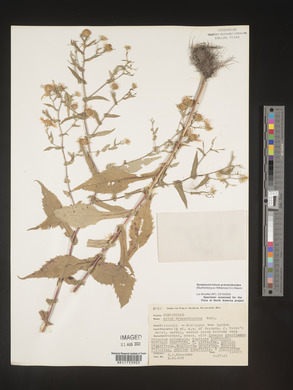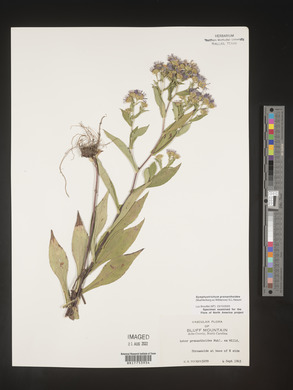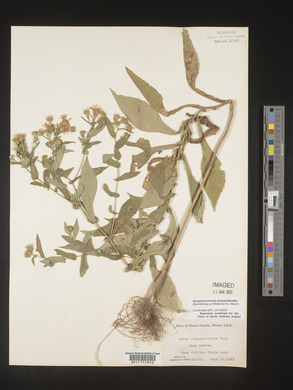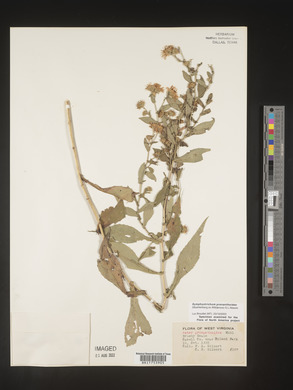Symphyotrichum prenanthoides
|
|
|
|
Family: Asteraceae
Crooked-Stem American-Aster
[Aster prenanthoides Muhl. ex Willd., moreAster prenanthoides f. milwaukeensis Benke] |
Perennials, 20-90(-120) cm, colonial; long-rhizomatous. Stems 1(-3+), ascending to erect (usually flexuous, sometimes ± straight, sometimes stout, older often dark purple), glabrous proximally, moderately hirsute distally. Leaves thin, margins scabrous, apices mucronate, abaxial faces glabrous, midveins hispid to glabrate, adaxial scabrous; basal withering by flowering, petiolate (petioles slender or slightly winged, bases reddish, dilated, sheathing, ciliate), blades obovate to oblanceolate, 15-70 × 10-20 mm, bases attenuate, margins crenate-serrate, apices acute to obtuse; proximalmost cauline withering by flowering, proximal mostly persistent, petiolate to subpetiolate (petioles ± widely winged, bases dilated, strongly auriculate-clasping), blades ovate to lance-ovate or elliptic-lanceolate to oblanceolate, 80-160(-200) × 15-55 mm, progressively reduced distally, bases attenuate, margins sharply serrate (teeth mucronulate), apices acuminate to subcaudate; distal subpetiolate or sessile (petioles broadly winged, auriculate-clasping), blades oblanceolate to lanceolate, sometimes panduriform, 7-90 × 2-25 mm, progressively reduced distally, more sharply so on branches, bases attenuate (petiolate) or ± cuneate to auriculate-clasping and slightly constricted above auricles (panduriform), margins serrate or entire. Heads in broad, ± flat, corymbo-paniculiform arrays, branches often purplish, divaricate to ascending, slender. Peduncles (8-)10-40 mm, sparsely to densely hispid, bracts lanceolate to linear-lanceolate, 3-12 mm, somewhat grading into phyllaries. Involucres campanulate, 5-6 mm. Phyllaries in 4-6 series, oblong-lanceolate or -oblanceolate, slightly constricted near middle (outer) to linear-lanceolate or linear (inner), ± unequal (flexible), bases indurate 1 / 5 - 1 / 2 , margins ± narrowly hyaline, scarious, erose, sometimes ciliolate distally, green zones lanceolate to linear-lanceolate (inner), often distally foliaceous, sometimes outer ± entirely so, apices spreading to ± squarrose, acute to acuminate, mucronulate, abaxial faces sparsely hirsutulous to glabrate or glabrous, adaxial glabrous or sparsely hirsutulous. Ray florets 17-25(-30); corollas usually lavender to blue, rarely white, laminae 7.5-12(-15) × 1-2 mm. Disc florets 39-50(-65); corollas cream colored or light yellow becoming purple or brown, 3.5-5 mm, tubes ± equaling campanulate to funnelform throat Flowering Aug-Oct. Moist or swampy grounds, woods, thickets, meadows, seeps, stream banks, roadsides; 100-1500 m; Ont.; Conn., Del., D.C., Ill., Ind., Iowa, Ky., Md., Mass., Mich., Minn., N.J., N.Y., N.C., Ohio, Pa., Va., W.Va., Wis. Symphyotrichum prenanthoides is of conservation concern in Canada and in a number of states.
Colonial from well developed creeping rhizomes; stems 2-10 dm, often zigzag, pubescent in lines, becoming uniformly so under the heads and glabrate toward the base; lvs chiefly cauline, scabrous to glabrous above, glabrous or loosely hairy along the midrib beneath, the main ones mostly 6-20 נ1-5 cm, with ovate or lanceolate, serrate, acuminate blade abruptly contracted into a relatively long, generally entire, broadly winged, strongly auriculate-clasping petiolar base; heads several or many in an open, sparsely leafy-bracteate infl; invol glabrous, 5-7 mm, its bracts acute or obtusish, seldom much imbricate, rather loose, often with spreading tip, the outer sometimes wholly herbaceous; rays 20-35, blue or pale purple (white), 7-15 mm; achenes strigose; pappus yellowish; 2n=32, 48, 64. Streambanks, meadows, and moist woods; N. Y. to Minn., s. to D.C., Ky., Io., and in the mts. to N.C. and Tenn. (A. oticus) Gleason, Henry A. & Cronquist, Arthur J. 1991. Manual of vascular plants of northeastern United States and adjacent Canada. lxxv + 910 pp. ©The New York Botanical Garden. All rights reserved. Used by permission. From Flora of Indiana (1940) by Charles C. Deam Infrequent on wooded flood plains and in roadside ditches in a few counties of the southeastern part of the state. It has been reported from a few of the central counties and no doubt its range will be extended in Indiana, although I believe it is a rare species in the state. …… Indiana Coefficient of Conservatism: C = 8 Wetland Indicator Status: FAC |



























































































